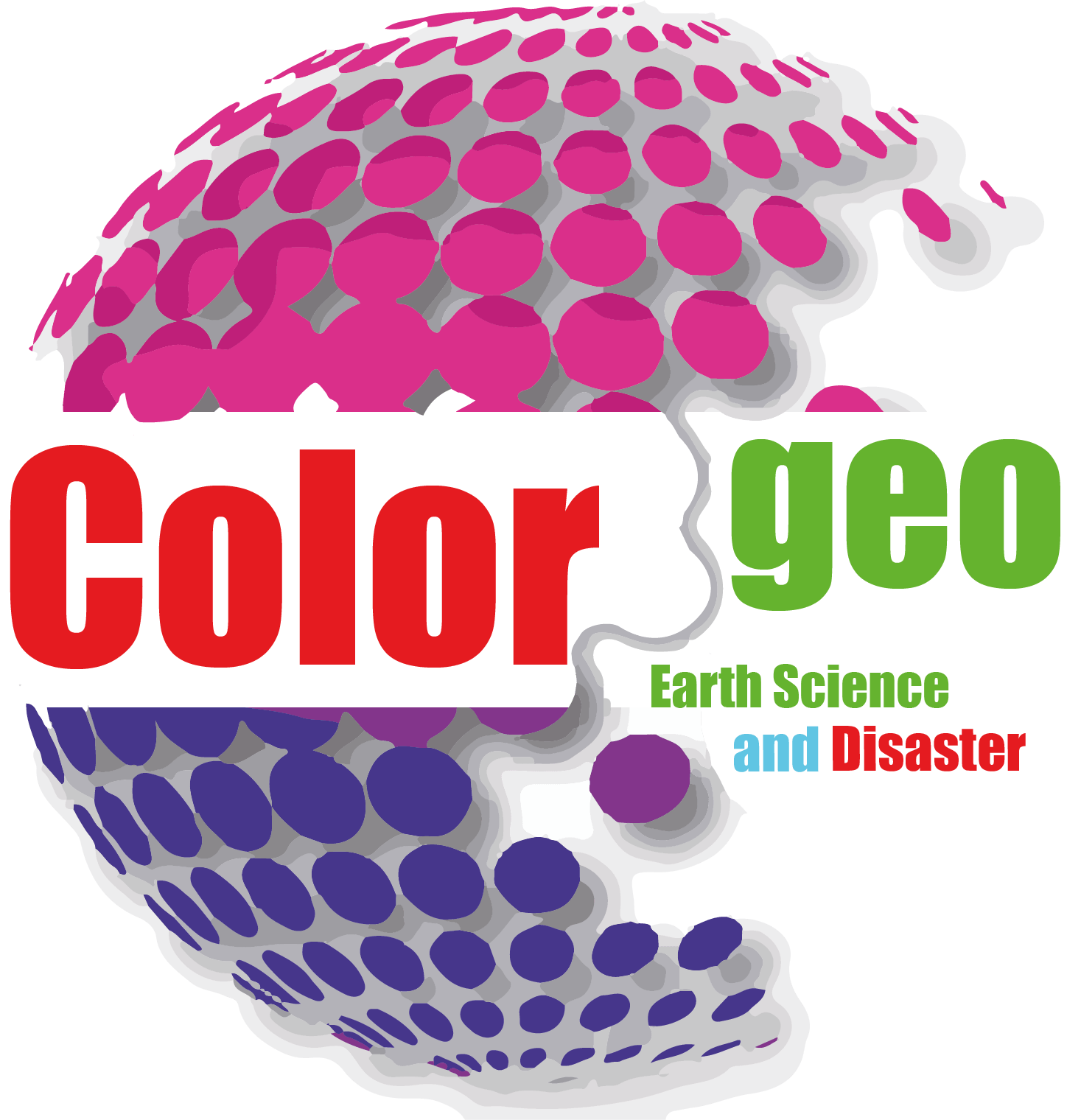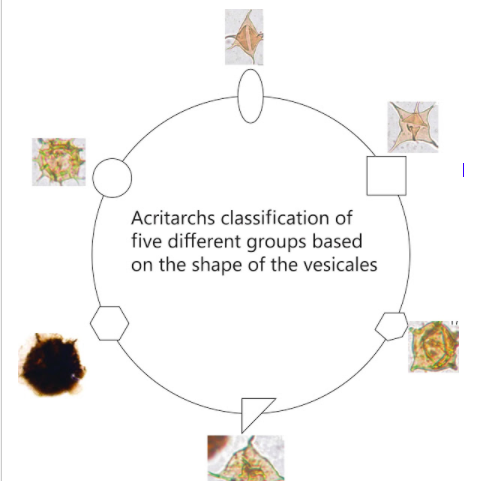The Causes of the Permian Extinction are still Controversial?
Before knowing that let’s learn some basic terminology about the Causes of the Permian Mass extinction and other terms. Any substantial increase in the amount of Extinction suffered by a geologically widespread area during relatively short intervals of time is mass extinction.
Many species become extinct in the world so far around 30% of plants and animals of the time died out. The extinct organisms range of ecologists not only in a particular forms of plants and animals but in microscopic and large forms also goes extinct. Extinction is worldwide covering most of the continent and the ocean.
The extinctions happened in a relatively short interval of time and at a greater rate of extinction than the background rate of extinction level because due to some species can go extinct naturally but for the mass extinction they must have extinct at a higher rate, drastically, for a short interval of time.
The previous history shows that all five mass extinction has closely linked with global temperature. The Permian mass extinction has the highest magnitude of temperature rise and rate of temperature change also faster than the other mass extinction of the time.
The previous five mass extinction, all face the decline of biodiversity during the no-oxygen-environment of the earth in the past after forming the Earth, there was negligible oxygen present in the atmosphere and the amount of present O2 of the present atmospheric level was less than 0.01% and the species was sulfur-induced species. Gradually the oxygen level increased by 100% PAL in the Permian world during that time the mass extinction happened.
The diversity of mass extinction:
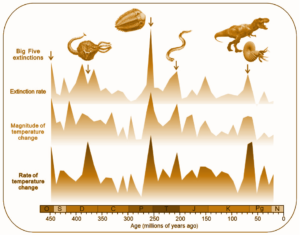
The diversity of mass extinction (Credit; Nature communication) The Permian mass extinction is huge destruction of biodiversity. It is called the great dying event. It occurred 252 million years ago.
Almost all the brachiopods, bivalves, Crustaceans, corals, graptolites, gastropods, and trilobites were extinct. 90 percent of the marine species goes extinct and 70% of the terrestrial species died out during the Permian Triassic mass extinction.
There was a major loss of terrestrial flora mostly coinciding with the end of the Permian extinction. The terrestrial devastation is demonstrated by the mass disappearance of the Gigantopteris mega flora.

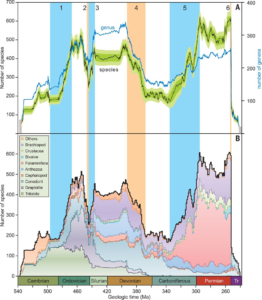
The wildfire is indicated by the increased amount of dibenzofurans followed by high Mercury concentration from southwestern China coincided with environmental plant Extinction and the end of Permian terrestrial ecosystem devastation.
The devastation events which occurred during the Permian time by the volcanism evidenced by the pared coronin is a high-temperature combustion proxy and Mercury spikes as a defined proxy for large igneous Province (LIP) emplacement indicate that discrete volcanic eruption could have caused the terrestrial ecosystem crisis followed by by the marine ecosystem crisis.
Based on the coronin index as a high-temperature combustion proxy and Mercury spikes the indication to identify the volcanic eruption event that could have caused the traditional ecosystem crisis followed by the Marine ecosystem crisis.
The erosion event led to an algal bloom which release the toxic components and the oxygen-depleted near shore bottom sea water which served as environmental stresses for Nearshore Marine animals.
The evidence from Delta 18 oxygen isotope value indicates that 10 degrees Celsius temperature increase in surface seawater across the end of marine Extinction.
How fast was the Permian mass extinction?
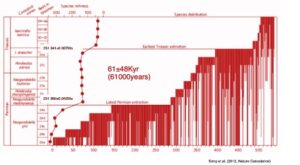
The 61 thousands of years is a very long time in comparison to the human life span on the other hand in terms of geologic time scale it is an instant.
The sixth mass extinction is already going on but we do not recognize these things because of human lifespan. The background Extinction rate from the previous five mass extinction is very low than the recent sixth mass extinction event it is higher than the background extinction level is very important to know about the Permian mass extinction.
The distribution of the land of the Permian Triassic Mass Extinction

The climate of the Permian is hotter than today. Around 12 degrees Celsius temperature increased which causes the tropical humid climate is much hotter.
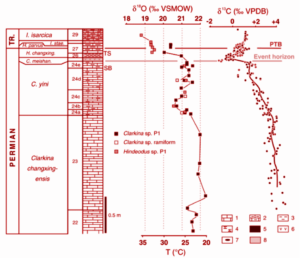
Global warming at the Permian mass extinction. Credit: Joachimski et al. (2013, Geology) There was no ice cap on the North Pole and the South Pole at the time of mass extinction is calculated by the oxygen isotope ratio, the Delta 18 oxygen which shows a 12° Celsius increase in 60,000 years.
In comparison to the recent world, it shows that the recent world is facing a much higher increasing rate of temperature of up to 0.02 degrees Celsius per year whereas the Permian extinction has a temperature rising rate of 0.0002 degrees Celsius per year. So the recent world is getting hotter every year much faster than the previous Extinction event.
Permian mass extinction globally impacted all of the earth. There was diverse dominant animal on land and Lystasaurus and Dimetrodon, reptiles like an animal in the Permian period, and other amphibians on land were the dominant animals. In the ocean, the Permian period is dominated by brachiopods and ammonoids.
What are the actual causes of the Permian mass extinction?
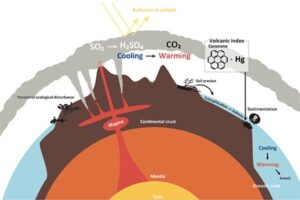
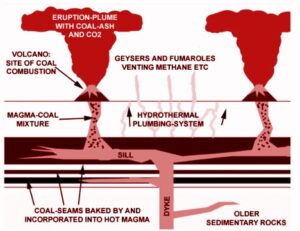
That is still a debate on the Permian mass extinction event so far the most accepted hypothesis is the Siberian trapped volcanism that causes the Permian mass extinction. The Siberian volcanism emits sulfur dioxide and causes acidic rain which is responsible for the devastation of plant life on land.
The driving mechanism for the Permian mass extinction is the volcanic eruption from Siberia which causes them to increase the emission of sulfur dioxide that’s how sulfur dioxide reacts with water to form sulfuric acid and falls as an acid rain causes plant death and the food chain collapse ultimately the terrestrial mass extinction occurred which increases the plant death.
The soil erosion event which causes the increased nutrient supply to the sea resulting in the algal bloom in the ocean which takes the dissolved oxygen from the ocean water than the ocean water has lack of oxygen which cause the Suffocation of fish and other marine animals which is ultimately the cause of the Marine mass extinction.
On the other hand, thermogenic gas emissions like carbon dioxide methane, or other gases cause global warming and in the ocean, it causes anoxia which ultimately causes marine mass extinction. The Siberian Trap eruption continues for at least 1 million years but the duration of the Permian Extinction is 61,000 years.
The Siberian Trap eruption occurred and it makes the geologic unique features called the stratified accumulating lava beds every year. The huge amount of magma that erupted from the core caused mass extinction.
The recent events of magma eruption comparison with the Permian eruption we can discuss magma eruption by the mid-oceanic ridge which erupts 1.4 cubic kilometers per year and another is in 1978 to 1784 years ago the lucky eruption of lava flood which has 14.7 Km3 per year whereas 2 to 5 km3 per year is the Permian eruption by the Siberian trap eruption which is still less amount to cause Permian mass extinction?
If so, then what is the main cause of the Permian Triassic extinction?
What really causes of the permian extinction?
In the Siberian trap, volcanism comes with a 3 km thick coal bed below the volcanic plume of eruption. the magma mixed with the coal-bearing formation and erupt which causes the Permian mass extinction. the magma and coal mixing lava eruption causes the expansion of carbon shoot particles in the outer atmosphere which makes the sunlight block for one to three years. it makes the world cool.
The environment then gradually increases in temperature and causes global warming. Siberian trap eruption occurred associated with the coal-bearing cool bed of 3 km thick causing the magma eruption to mix with coal which is the reason for the Permian mass extinction.
In the Permian mass extinction, the magma with coal mixture erupted at a high altitude making the carbon black particle in the upper atmosphere which causes the sunlight to block and then mix to cool for 3 years period followed by global warming. The findings are published in many reported journals.
The actual causes of the Permian mass extinction are still in debate. Some scientist says the Siberian Trap eruption continues for 1 million years during that from space a gigantic asteroid hits the planet and causes mass extinction. The Siberian trap eruption might be the acceptable hypothesis for the Permian mass extinction event. To identify the actual cause of the Permian mass extinction researchers can use biomarkers.
Biomarkers are derived from fossil records of the lipid of organisms then decomposed in the rocks and are converted to a stable compound called the biomarker. A biomarker is a very effective tool for the identification of paleoenvironments of the past. There are many types of biomarkers that are very important to know the past environment. One of the most popular biomarkers are pristine, phytane and sterane, hopane. and coronen to identify the Permian Triassic mass extinction research.
2 Major Causes of the Permian Extinction
Cause of Permian extinctions; In 252 Million years ago what happened?
Already Earth has past its 4.5 Billion Years. And through this interval of time, earth has experienced 5 mage mass extinction. One of them is the Permian Triassic mass extinction. The main reason for this great dying event is still a great concern among geologists and paleontologists. The main reason for extinction is mainly two:
1. External causes Causes of the Permian Extinction
The meteorite impact from the outer space
2. Internal causes Causes of the Permian Extinction
Siberian flood basalt volcanism, sea-level change, ocean anoxic events (detoxification), global warming due to the huge release of the under-ocean methane clathrates, The water collum stratification, Ocean acidification, etc.
Recent Findings of the Biomarker Study:
One of the recent findings is the input of terrestrial organic matter which caused the excess primary production in the ocean and finally, the ocean became anoxic (no oxygen in the ocean water). The biomarker study can play a role to investigate that finding. The biomarker is the geochemical stable compounds that are formed after the diagenetic and cytogenetic effects of the buried organic matter. Like, Pristane and Phytane.
Research Finding for the Causes of the Permian Extinction
The biomarker can tell us the past depositional environments and the clue of the past event. Hopanoid is a larger group of compounds formed from lipids. Then after diagenesis and catagenesis it stops and remains in the sediments as a Hopane, Moretane, etc.
Hopane and Moretane are the same hopanoid group of geochemical fossils preserved in the sedimentary source rocks. C30 ab hopane is more stable than Montane. Usually, in the petroleum source rocks preservation of hopane and Moretane ratio are 20:1. The amount of hopane than Moretane in the source rocks depends on the maturation of the rocks.
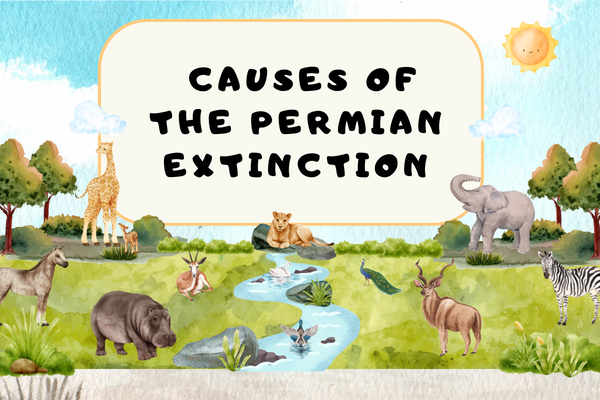
The more mature or the abundance of hopane than a moretane. During the categenesis the mostly found hopane than moretane. In the GC MSMS, we can measure the hopane and moretane by the Multiple Reaction monitoring methods (MRM) from the aliphatic compound samples (F1a).
The Mass fragments (m/z) for identification of hopane and moretane are the same as (M/z; MRM 412.5- 191.3) but the main trick to identify hopene and moretane separately is the Kovats index value.
The value of Kovats indices of C30 αβ Hopan (MRM 412.5- 191.3) and Moretane (MRM 412.5- 191.3) is 3068 and 3106 respectively. In the GC MSMS chromatogram, the C30 αβ Hopan (MRM 412.5- 191.3) appears first then the peak of moretane will appear and the M/Z is the same as the C30 αβ Hopan (MRM 412.5- 191.3) because moretane is the diagenetic product of hopane group but less stable hence less abundance than ab hopane. Moretane will appear just 0.5 min later than C30 αβ Hopan (MRM 412.5- 191.3).
What Causes of the Permian Extinction?
In sedimentary rocks, hopanes are the most abundant geochemical marker usually hopane is produced by bacterial synthesis. The hopane has 5 stereoisomers like aa C30 Hopan, ab C30 Hopan bb C30 Hopane, and ba C30 Hopane. Among them, ab hopane is more stable after sedimentary diagenesis and cate-genesis. The ba c30 hopane is also called the Moretane.
The ratio of ab C30 Hopan/Moretane is the marker for the identification of the maturity in the Petroleum industry even in the geological study. The Moretane is usually more in the immature rocks and in the peat, coal enriches sediments.
For the identification of the Permian Mass extinction, this hopane and moretan ratio play a major role. Scientists discovered the Permian marine extinction (252 million years ago) one of the causes is the excess input of the terrestrial organic matter.
They found the increased value of the hopane/moretane ratio from the Meishan Section (The Global stratotype and section point) in South China. This discovery indicates the excess input of terrestrial organic matter in marine sediments.
Terrestrial input to the marine environments is due to the collapse of the tree and land plants during the Permian age which is ultimately one of the causes of the great dying, especially for the marine environments. Still, Scientist needs to identify the effect of the extinction which had affected the land plants. So, we need to identify the same hopane/ moretane anomaly for the terrestrial sample.
Which is most likely to cause a mass extinction?
Life on Earth has witnessed several cataclysmic events throughout its existence, including mass extinctions that have reshaped the planet’s biodiversity. While these events are rare, their impact is profound, leading to the loss of numerous species and altering ecosystems.
In this article, we delve into the factors that could contribute to a mass extinction, focusing on carbon dioxide levels, volcanic eruptions, human activities, and their implications for marine species and life on Earth.
-
Carbon Dioxide and Global Warming: Carbon dioxide, a greenhouse gas, plays a vital role in regulating the Earth’s temperature. However, excessive amounts of CO2 can cause a significant rise in global temperatures, resulting in global warming. This phenomenon disrupts ecosystems and places stress on various species, making them susceptible to extinction. Historical records indicate that periods of high carbon dioxide levels have coincided with mass extinction events.
-
Volcanic Eruptions and Environmental Upheaval: Volcanic eruptions release large amounts of gases and ash into the atmosphere, triggering significant environmental changes. These eruptions can lead to climate cooling, acid rain, and alterations in sunlight penetration, adversely affecting photosynthesis and disrupting food chains. Volcanic eruptions in the past have been associated with mass extinction events, causing widespread species die-offs.
-
Human Activities and Ecological Disruption: Human activities have dramatically impacted the environment, altering habitats, degrading ecosystems, and increasing pollution. Deforestation, habitat destruction, overexploitation of resources, and pollution have accelerated extinction rates. The rapid changes caused by human activities can exceed the adaptability of many species, leading to their decline and eventual extinction.
-
Marine Species and the Fragility of the Oceans: Marine species face particular vulnerability in the face of mass extinction events. Increasing carbon dioxide levels contribute to ocean acidification, disrupting the delicate balance of marine ecosystems. Rising sea levels and changing temperatures further threaten the survival of various marine species, including coral reefs, which serve as vital habitats for countless organisms.
-
The Fossil Record and Lessons from History: Studying the fossil record provides valuable insights into previous mass extinction events. The fossil record reveals that the loss of a single species can trigger a domino effect, resulting in cascading extinctions across multiple taxa. Understanding the past can help us comprehend the magnitude of the current threat and take preventive measures to mitigate the sixth mass extinction.
-
The urgency for Action and Future Perspectives: The current rate of species loss is alarming, and urgent action is needed to mitigate the factors leading to mass extinctions. Reducing carbon dioxide emissions, transitioning to sustainable practices, and preserving critical habitats are essential steps to safeguarding biodiversity. International collaborations and raising awareness about the importance of ecological balance are crucial in ensuring the future survival of diverse life forms on Earth.
Mass extinction definition biology:
A Mass extinction (গন বিলুপ্তি) is a widespread and sudden decrease in the biodiversity on the planet due to some geological phenomenon.
The extinction event may happen gradually with some phases of the slow extinction process. There is 5 mass extinction for far happened in Earth’s history.
Which is most likely to cause a mass extinction of;
1. Late Ordovician Mass extinction
2. Late Devonian Mass extinction
3. Permian-Triassic Mass extinction
4. Triassic- Jurassic Mass extinction
5. Cretaceous Paleogene Mass extinction
6. Holocene mass Extinction
Permian Extinction:
It is known as the Great Dying event in Earth’s history. It happened in 251.94 Ma ago. More than 90% of all marine species and 70% of the land creature had been eliminated throughout the world.
There are many hypotheses about the Permian Extinction event caused:
The ocean anoxic events;
Anoxia is one of the oxygen deficiency conditions of the ocean. The excess amount of oxygen consumption by bacteria or some other organisms makes the ocean water anoxic. A sulfur-induced redox reaction is another cause of the anoxic ocean. This anoxic ocean water was a threat to the ocean creature and the small and large animals died out during the Permian Triassic mass extinction.
Soil Erosion Events;
Due to forest fires, a huge amount of terrestrial soil input in the ocean makes a high amount of primary production. The nutrient input from the soil makes the ocean water highly nutrient and produces a high amount of primary producers like Phytoplankctone and other microorganisms. This primary production makes the ocean water anoxic.
Global Warming events;
Scientists believe that the Permian Triassic mass extinction was due to global warming. The relationship between global warming and volcanic eruption has a link. If the volcano erupts then the huge amount of CO2 makes the globe warm.
Siberian Traps;
The Siberian volcano had a huge eruption and it has a 4 km thick lava, called Siberian Traps, Renne, measured the age of the trap-rocks and a rock of the Permian time from China. He found a 100000 years gap between these two. Scientists discovered the cause of the extinction in relation to the Siberian Traps.
Actually, a volcano was not the cause but the impact was the cause of the extinction. When a volcano erupts a huge amount of CO2, SO2, and soot emit into the atmosphere. The SO2 and soot caused the acid rain, the sunlight blocked and decrease the temperature.
The cooling temperature initiates the formation of glaciation and results in the shallow sea and lowering the diversity of the marine creatures. The shallow sea also releases the ocean methane which causes the greenhouse effect and increases the global temperature.
Geologists and Paleontologist Believe that the Permian Triassic Mass extinction was not caused by a single event but rather by multiple events together or simultaneously happened.
The survivors of the great dying are today’s creatures. Death creates opportunities. Hence, Survivors occupy the places.
Late Devonian extinction:
The late Devonian extinction is one of the five major mass extinction in Earth’s history. It happened 440 Ma years ago. It is also called the Frasnian Famennian Mass extinction. The Devonian is familiar with the diverse range of fishes and it is called the Age of Fish.
The Late Devonian extinction died out more than 70-80% of all species and 20% of all families during that time. The duration of the extinction was 20-25 Ma (Million Years) according to the famous geologist Thomas Algeo et. al. (2000).
The Late Devonian extinction event consists of two separate events;
-
Kellwasser Events at the Frasnian Famennian Boundary
-
Hangeberg Events at or near the Devonian and Carboniferous Boundary.
The organism extinct were mainly, ammonites, benthic foraminifera, jawless fishes, trilobites, brachiopods, etc.

The Main Causes of the Late Devonian Extinction:
There are many causes that have been proposed so far for the Late Devonian Mass Extinction, like, Asteroid impact, Plate tectonics, Sea level changes, Climate change, Global anoxia (Oxygen poor bottom water), etc.
One of the most accepted hypotheses for extinction is the flourishing of terrestrial vegetation. This hypothesis is proposed by Thomas Algeo.
According to this idea, the highly emerging terrestrial vegetation developed and cause the high input of the nutrient in the seawater.
The excess amount of nutrients (Ca, Mg) removes the CO2 from the atmosphere. The loss of this greenhouse gas cools the atmosphere with sea-level drops and causes mass extinction.
Another group of scientists claimed that this terrestrial plant cause soil erosion and high input of nutrition cause high primary production which causes anoxic bottom water and death out organisms and small creatures.
So, about the Late Devonian extinction still, scientists need to explore the scenario of the cause of the mass extinction.
Conclusion: The prospect of a mass extinction event looms over our planet, driven by factors such as carbon dioxide emissions, volcanic eruptions, and human activities. Understanding the impacts of these factors on marine species and the delicate web of life on Earth is essential for preserving biodiversity. By acknowledging the lessons from the fossil record and taking prompt action, we can strive to prevent mass extinction and protect the irreplaceable richness of our natural world for future generations.
Permian Triassic Extinction another 2 Causes: The Fungal spike events
The late Permian Triassic Extinction (252 Ma) was the most devastating. It almost wiped out all the land species (95%) including the widespread flora of Gondwana Land and affected non-marine, marine vertebrates, and invertebrates. These great events were evidenced by extensive soil erosion events on land, wildfire, replacement of lower plants than trees, and the complete loss of the peat-forming vegetation.
The two most important phases of these events were evidence of the great event; Permian Triassic Extinction.
A sudden flourish of unknown origin of acritarchs in marine environments. These two events represent the tremendous amount of the stress environments in which these stress-tolerant organisms survived and they are the marker of the Permian Triassic mass extinction of 252 Ma ago.
There was a still huge debate about the real cause of the Permian mass extinction. The internal cause of the Permian Mass extinction was a widespread oceanic anoxic event, global climate warming caused by the sudden release of methane clathrates, and massive soil erosion events. The internal cause of the great dying events is thought to be the extraterrestrial impact, like meteorite strikes.
Scientists found some evidence that just after the Permian mass extinction the environment was very stressful and they found evidence of that stressful environment on land and in the sea.

The fungal spike events of Permian Triassic Extinction.
The Fungal spike or Fungal event is a thin layer found in many places of non-marine and marine sediments of the latest Permian extinction.
The devastated forest of the latest Permian extinction was followed by the brief interval and widespread of fungal spike. This fungal spike is mainly by the fungal cell of Reduviasporonite.
The morphological characteristics of Reduviasporenite are similar to modern Ryezoctonia. Some scientist says it to be the algal origin which was widely spread out during that time. carbon and Nitrogen isotope value is similar to that of fungal spike rezuviasporonite which indicates the fungal species.
Fungal spike events in both the non-marine and marine sediments with a negative shift of the d13 carbon isotope value indicate the coincidence of the Latest Permian extinction events.
The Acritarchs Events of Permian Triassic Extinction.
The acritarchs are organic-walled micro-fossils of unknown origin. The size of acritarchs can vary between 20-80 microns. They are very oldest fossils in paleo history. In the Latest Permian age, they are found across the Permian Triassic Boundary.
So, They are P/T Boundary markers. Acritarchs are specially characterized are they are organic-walled with an ornament or spike with five different shapes.
They are classified into five different types based on the shapes of the cuticles. like, rectangle, pentagonal, hexagonal, Triangle, Square round, and Oval-shaped acritarchs.
These stress-tolerant acritarchs are phytoplankton in origin some scientists claimed.
The study revealed that irrespective of origin they are widely found across the Permian Triassic Boundary followed by the latest Permian mass extinction.
These two (Fugal Spike and Flourish of Acritarchs) events might have been the marker of the deadly Permian extinction events in which more than 90% of all species were wiped out. The extensive research on this event still may be enigmatic. Because scientist believes that Siberian volcanic eruption during the main phase of the Permian age may cause extinction.
As a trigger, many of the chains of events may come into play to finally cause the Great Dying event. After the extinction, the Permian environments were so severely bad that it took a long time to recover from this great disaster until Mid-Triassic.
There are many combinations of the events to cause the Permian Triassic extinction 252 million years ago. The Siberian eruption is one of them.
Changes in Biosphere and Marine Environment across the End-Permian Mass Extinction at Shangsi, South China
Mass extinction is one of the biggest issues in the paleo history. The earth once faced a mega-disaster and this can be understood by studying mass extinction. Here is my MS thesis, I studied the Causes of the Permian Extinction at Tohoku University under the supervision of Prof Kunio Kaiho in 2016.
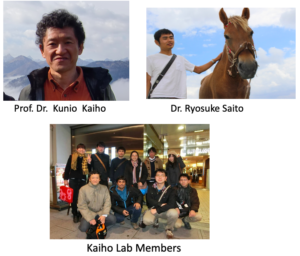
Changes in Biosphere and Marine Environment across the End-Permian Mass Extinction, South China PDF
Mass extinction